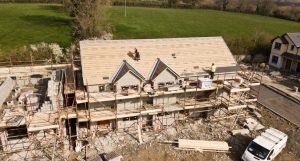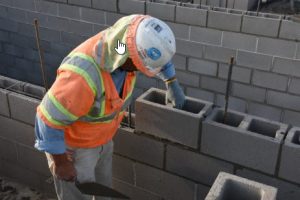Masonry Damage Inspections
Masonry damage Inspections are used when there exist masonry forensic problems in older as well as newer buildings, especially in Texas, Louisiana, and Mississippi. Here’s an overview of 10 common construction problems that masonry engineers face during a masonry damage inspection service.
Efflorescence Noted in Masonry Damage Inspections
When water containing dissolved salts evaporates from a masonry structure it leaves a salt deposit (Figure 1). The stain is called efflorescence. Salts may be present in all types of masonry materials: mortar, brick, concrete block, stucco, and plaster. Or they may be in water that enters the masonry
Besides being unsightly, efflorescence may lead to more serious problems such as cracking. Salt crystals deposited in pores sometimes generate enough pressure to crack the masonry.
To prevent efflorescence, prevent water from entering the wall and provide drainage for water that does. Design properly and install flashing, weep holes, drips, and caulking.
PROBLEM In Masonry Damage Inspections
Corrosion In Masonry During Inspections
In the presence of water and oxygen, steel rebars in bond beams, grouted cells, or collar joints will corrode. Horizontal joint reinforcement ties that hold multi-wythe masonry walls together, or anchors that attach a veneer wall to support also are susceptible to corrosion.
Rust, the product of corrosion, occupies up to six times the original volume of steel. This volume expansion causes cracks that let in more water and thus cause even more corrosion.

The most common materials used for reinforcing are uncoated steel, zinc-coated steel, and hot-dipped galvanized steel. The coatings and the alkaline mortar provide some corrosion protection. There is, however, no substitute for good tight mortar joints and flashing that minimize the amount of moisture entering and accumulating in the masonry.
Also, avoid adding chloride to mortar or grout; soluble chlorides accelerate corrosion. And don’t install dissimilar metals such as copper and steel on the same wall. When there’s moisture in the wall, dissimilar metals sometimes react and cause corrosion too.
Concrete Masonry Damage Inspections
Concrete masonry is a popular building material in part because of its strength, versatility, durability, economy, and resistance to fire, impact, noise, and termites. To function as designed, however, concrete masonry buildings must be constructed properly.
Concrete masonry is used in projects ranging from small single-story buildings to multistory loadbearing projects and is used in every building type and occupancy, including institutional, residential, commercial, and manufacturing facilities. Because of the varying nature of these facilities, masonry construction continues to evolve, becoming more detailed and multifaceted. Reinforced masonry requires masons to not only lay masonry units but to also properly place reinforcing steel and grout. As the intricacy and variety of masonry systems continue to expand, so does the need for educated and knowledgeable inspectors to verify that masonry is being constructed as designed. Likewise, ensuring that the physical properties of the masonry materials comply with project specifications requires detailed knowledge of testing procedures.
Many masonry projects of substantial size require the implementation of a quality assurance program. A quality assurance program includes the owner’s or designer’s efforts to require a specified level of quality and to determine the acceptability of the final construction. As part of a quality assurance program, inspection includes the actions taken to ensure that the established quality assurance program is met. As a counterpart to inspection, quality control includes the contractor’s or manufacturer’s efforts to ensure that the final properties of a product achieve a specified goal under a quality assurance program. Together, inspection and quality control comprise the bulk of the procedural requirements of a typical quality assurance program.
Concrete Masonry Inspections
Inspection is one part of a quality assurance program, which is the administrative and procedural requirements set up by the architect or engineer to assure the owner that the project is constructed according to the contract documents. Inspection is one means of verifying that the project is constructed as designed using the specified materials.

Inspection assures that masonry materials and construction practices comply with the requirements of the contract documents. Inspectors, the inspection program, and inspection records should be addressed in the quality assurance program. Local municipalities may have minimum inspection requirements that augment or complement minimum code requirements to ensure the safety of the public. Additionally, the amount of inspection required depends on the owner’s needs. The architect or engineer will typically specify the degree of inspection necessary to meet the owner’s quality assurance program, local ordinances, and code requirements.